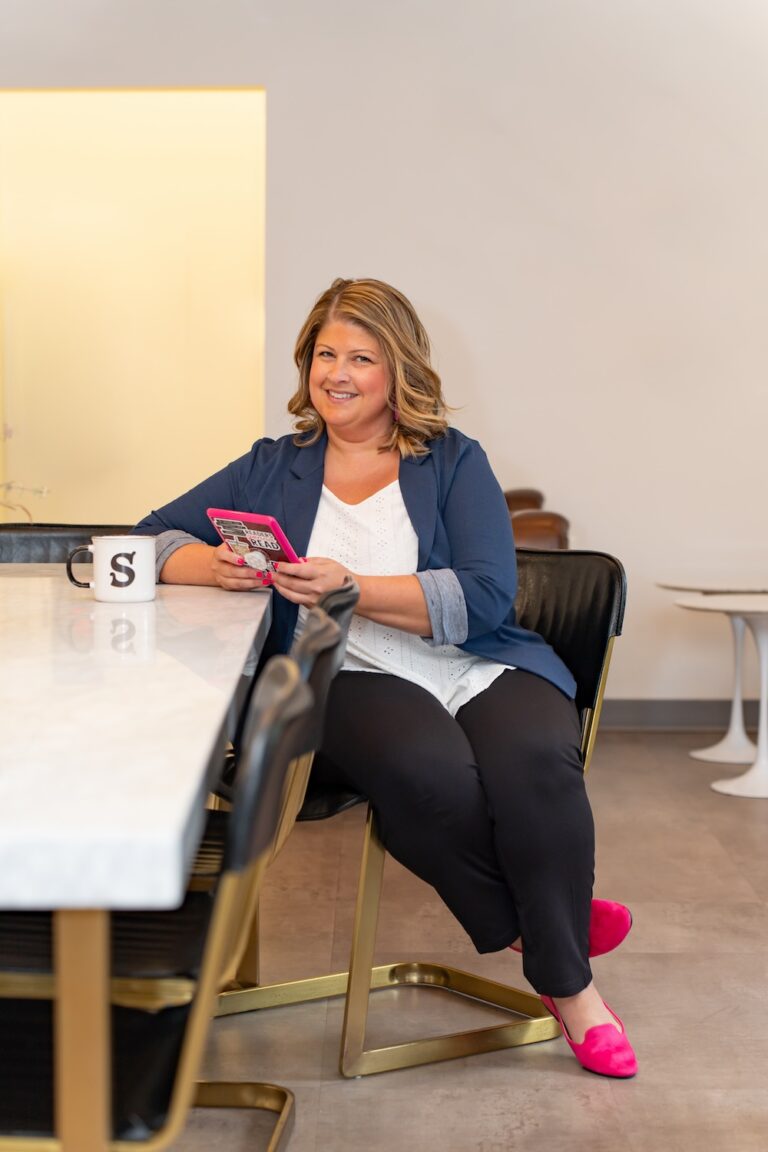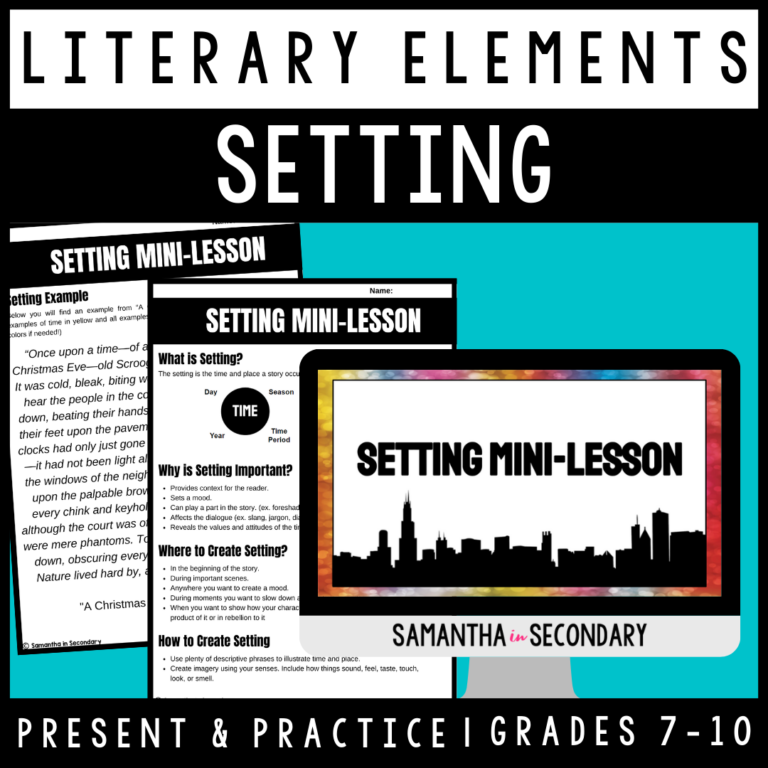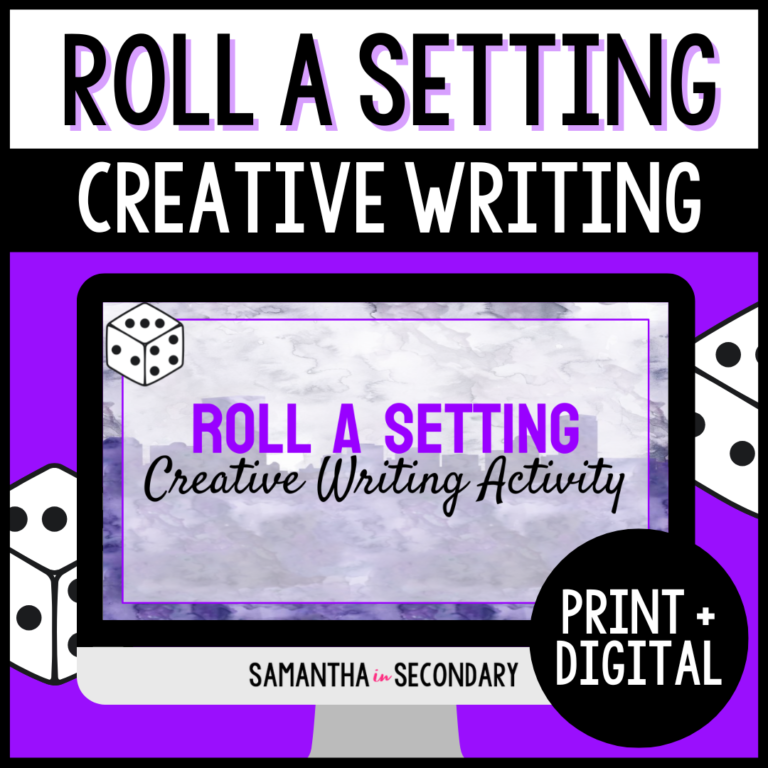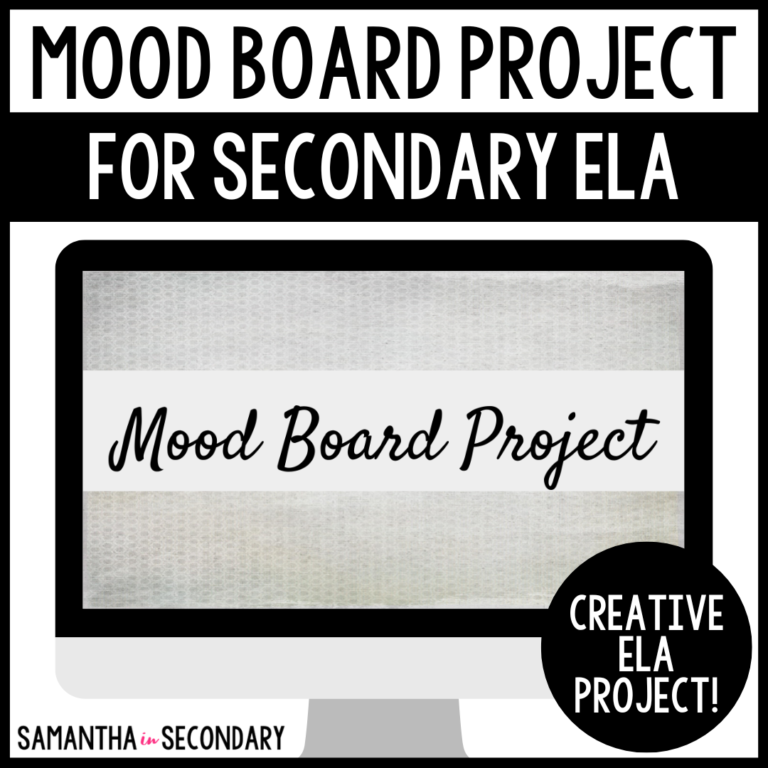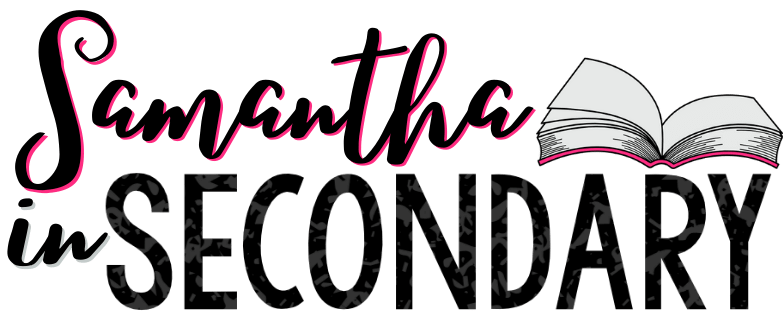Setting is your hook when we’re talking about historical fiction. I know it might not sound like the most thrilling lesson idea in the world, but stick with me because I have a few ideas that are going to be both fun and educational. Working through these activities always had students laughing and learning, so I know your students are going to love them, too.
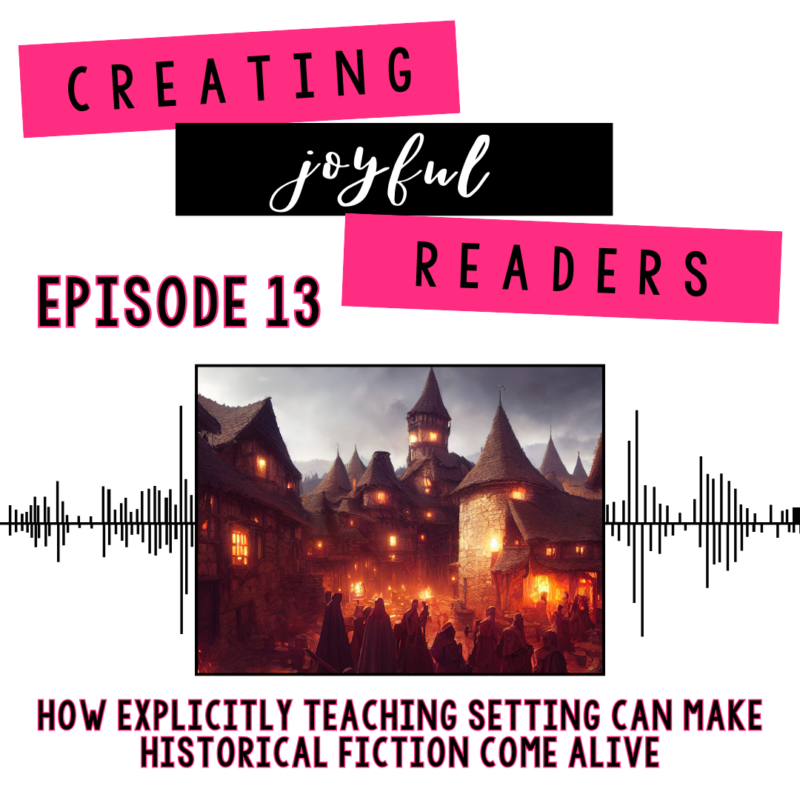
Links & Resources:
Some links referenced here are affiliate links. Supporting the podcast through these links comes at no additional cost to you.
Resources Mentioned:
–> Shop for your modern day literacy classroom HERE:
https://www.teacherspayteachers.com/store/samantha-in-secondary
–> For tips, book recommendations, and connection with other educators follow along on INSTAGRAM:
https://www.instagram.com/samanthainsecondary/
–> Shop my favorite YA books HERE:
Prefer to read? Open the transcript here.
Hello, joyful readers, welcome back to another exciting episode. Today we’re going to talk through one of my favorite ways to hook students when introducing historical fiction, and that’s through the setting. I love to pair a key literary element with a specific genre to help students delve deeper into the writer’s craft. Setting and historical fiction go together like peanut butter and jelly. I know it might not sound like the most thrilling lesson idea in the world, but stick with me, because I have a few ideas that are going to be both fun and educational. Working through these activities always had students laughing and learning so I know your students are going to love them too. Stay tuned, joyful reader, I have so much to share today.
Samantha 0:45
Welcome to Creating Joyful Readers, a podcast dedicated to empowering secondary educators with the tools, strategies, and inspiration to cultivate a lifelong love of reading in their students. I’m your host, Samantha. Tune in each week as we explore the transformative power of independent reading. Delve into the latest research on literacy, dissect projects that will help your students showcase what they’ve learned in a unique way, and share curated recommendations of young adult novels that will captivate and engage your learners. Join in as we embark on a journey to create joyful, lifelong readers one book at a time.
Samantha 1:22
I’m a firm believer that it doesn’t matter how old your students are, there is going to be some degree of reteaching when you’re discussing any literary element. This is one of the reasons I love to recommend genre based literature circles, because not only does it allow students to sample new genres, but it also lets them see the literary elements in action. In historical fiction, the setting is always the thing that stands out. It has to, right? You’re transporting readers to a different time and place. In order to do that, you have to be able to create a fully fleshed out setting. I always start historical fiction unit by reviewing the basics of setting. I explain what it is, why it’s important, and where it’s most appropriate to build a setting. I go over the explicit HOW of creating setting, and then follow up with examples. Often I’ll have students highlight mentor text with very clear instances of both time period and place, to show them that both need to be present to create a well rounded setting. I have an example that I want to share with you today. This specific passage is from All the Light We Cannot See by Anthony Doerr. I often use the first several pages of this book to show students how setting can hook a reader. This section is called leaflets. At dusk, they pour from the sky. They blow across the ramparts, turn cartwheels over rooftops, flutter into the ravines between houses. Entire streets swirl with them, flashing white against the cobbles. Urgent message to the inhabitants of this town, they say. Depart immediately to open country. The tide climbs. The moon hangs small and yellow and gibbous. On the rooftops of beachfront hotels to the east and in the gardens behind them, a half-dozen American artillery units drop incendiary rounds into the mouths of mortars. This passage is not only beautifully written, but it creates immediate urgency. These types of passages help readers see what’s possible. Not only is it helpful in a lesson to discuss setting, but it’s a masterclass in writer’s craft. The entire novel is a masterpiece, so if you haven’t read it, I highly encourage you to. Using samples of beautiful writing in your lessons can help to inspire students to see just how moving texts can be. If you want to use the specific setting lesson I use in my own classroom, you can head to my teachers pay teacher shop, Samantha in Secondary, and search for setting, or just head to the show notes for a link. My done for you resource includes all of the information about this literary element your students will need, plus some fun practice activities that will be both entertaining and educational with little to no prep for you. That’s the best, right? Many of the activities I’m about to discuss are included and ready for you to teach tomorrow.
Samantha 3:59
After you’ve solidified your students’ understanding of setting, it’s time to let them explore this concept in a way that truly brings it to life. By incorporating creative and immersive activities, you can transform setting from just a literary element into something your students deeply experience and connect with. I love using stock photo websites like Unsplash to curate stunning, unique images that spark students’ imagination. You can also use Canva to search for something inspiring. Simply typing in unique setting will give you a treasure trove of possibilities, whether it’s a misty mountain range or a neon lit cityscape, these visuals are the key to unlocking vivid descriptive writing. Alternatively, you can search for lists of intriguing settings through Google to inspire your photo search. One of my favorite activities is a write the setting exercise project. One of the photos you chose for your students and set a timer, challenging them to describe the scene using all the setting vocabulary and sensory details you’ve discussed. Let them paint with words. This isn’t just about identifying elements. It’s about creating atmosphere, mood and the world around their characters. Afterward, encourage them to share. Whether you choose full class discussions or turn and talks, the conversations that follow are rich and full of insights about how writers craft immersive worlds. For students who may struggle with this initial activity, you can guide them through a more scaffolded process that allows for deeper understanding and skill building. Start by choosing a photo with a unique setting and create a bank of descriptive phrases that match it. Or if time is tight, use technology like chatgpt to help generate some beautifully crafted sentences. Repeat this for a few more images, mix up the phrases and give them to your students as a sorting activity. They’ll match the phrases to the photos, and in doing so, they’ll see what lush, vivid writing looks like. This activity does more than just reinforced setting. It allows students to see examples of powerful, descriptive writing and gain confidence in their own ability to create it. They’re not just learning, they’re experiencing the joy and satisfaction that comes from crafting something beautiful with their words. By the end, your students won’t just understand setting, they’ll be ready to transform it into a tangible part of their storytelling.
Samantha 6:12
One of my absolute favorite ways to help students really grasp the concept of setting is with a roll a story activity. It’s such a simple but powerful tool to get even the most reluctant writers excited. The idea is that students roll dice to randomly pick story elements like time, place, mood and atmosphere. It’s kind of like sending their imagination on an adventure where the roll of the dice guides their creativity. And the best part, it completely eliminates that I don’t know what to write moment we’ve all seen in the classroom. The dice do the deciding, and students just get to dive in and start writing. Plus it adds this fun element of chance that makes storytelling feel like an exciting journey where anything can happen. I’ve got a free resource in my Teachers Pay Teachers shop, Samantha in Secondary to help. Just search for roll a setting, or check the show notes for a direct link. Another idea that’s super engaging and visually dynamic is creating a setting mood board. This is a great hands on project where students can either go old school with paper and cutouts, or they can use a digital tool like Canva to create their setting vision. The goal is to choose up to 10 photos that really capture the essence of their setting, and then they’ll write a reflection that connects the images to the time, place, atmosphere, and mood. That reflective piece is key because it helps them dig deeper into their creative process and gives you insight into their thinking. It’s also a great way to get students using those higher order thinking skills all while having fun creating a visual representation of the setting. Now, for those students who might need a bit more of a challenge, a setting dramatization mix up is perfect. Here’s how it works. You assign characters in a setting and students act out a short skit. Then comes the twist. Once they perform, you change the setting on them, suddenly they have to adapt to a completely new environment, whether it’s a windswept desert or a cozy cottage, this improv element really gets them thinking about how setting influences everything characters, dialogue and even the plot. It’s a fun and interactive way for students to see how much of an impact setting has on storytelling. These activities aren’t just about making setting more interesting, they’re about giving students the tools to really understand how to create vivid, immersive worlds in their writing. By the end of these activities, your students will have a deeper appreciation for storytelling and will be ready to bring their own unique settings to life on the page.
Samantha 8:34
That’s it for today’s episode, joyful readers, I hope you’re feeling inspired and ready to dive into some engaging activities that will bring the setting in historical fiction to life for your students. From using captivating photos, to roll a story activities, these strategies not only make learning fun, but also help students grasp how crucial setting is in storytelling. Remember whether it’s crafting their own settings or dramatizing how setting shifts can change everything, these activities will leave your students laughing learning and ready to tackle any literary challenge. And don’t forget, my roll a story activity is available for free in my Teachers Pay Teachers shop, Samantha in Secondary if you want to try it out.
Samantha 9:13
I can’t wait to hear how your students respond to these lessons. Be sure to let me know how it goes. And if you haven’t yet, make sure you’re subscribed so you don’t miss out on more exciting teaching ideas. Thanks for joining me today and until next time, happy reading.
Samantha 9:27
Thanks for tuning in to Creating Joyful Readers. I hope you found inspiration and practical strategies to ignite a passion for reading in your students. Remember every book we introduce and every reading experience we foster can transform lives and help students become lifelong readers. Follow me on social media at Samantha In Secondary for more tips, book recommendations, and to connect with a community of educators dedicated to making reading a joyful journey. Until next time, happy reading.
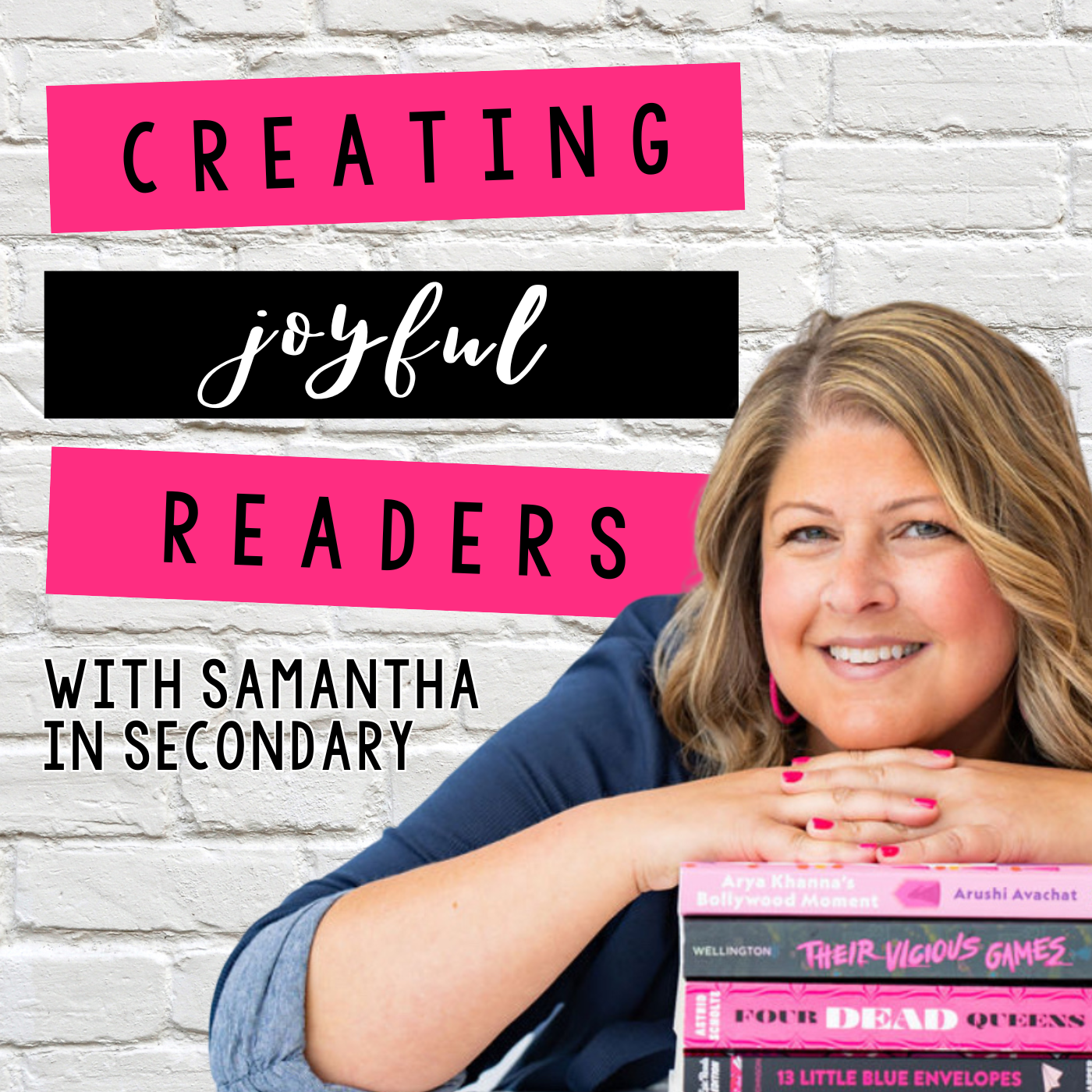
The Podcast
Creating Joyful Readers
It is possible to inspire a lifelong love of reading in secondary ELA students and that’s what the Creating Joyful Readers podcast is all about.
Join us every Monday as we dive into the latest in literacy research, talk about fresh Young Adult book recommendations, and chat fresh strategies to motivate your secondary students to love reading again.
Meet Your Host
Welcome! I’m Samantha, a veteran educator with 15 years of classroom experience and a Masters in Education, dedicated to transforming how students experience reading. My passion lies in empowering ELA teachers to foster joyful, independent readers in their classrooms.
Through this podcast, I’ll share the latest literacy research, practical tips, creative project ideas, and fresh book recommendations, all designed to help you ignite a love for reading in your students and make reading a delightful adventure, not a chore.
